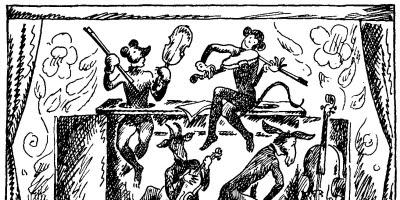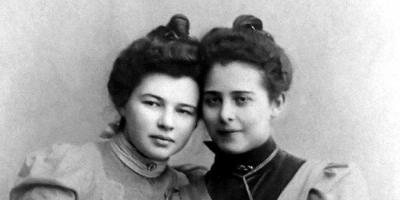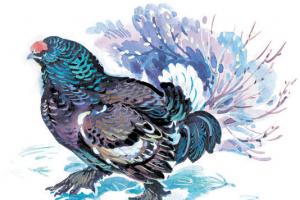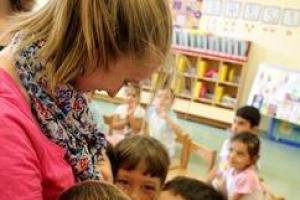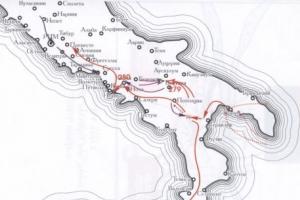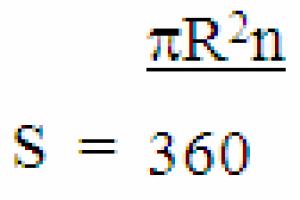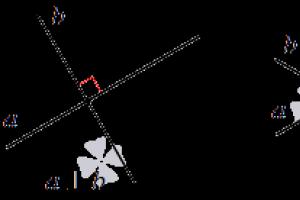English lesson (2nd grade)
Conceptual Purpose of Teaching English: ensuring the development of the child’s personality and abilities, laying the foundations for the formation of skills to communicate in a foreign language, familiarization with the culture of English-speaking countries.
Audience: 2nd grade.
Lesson topic:"Description of the animal."
Lesson type: integrated application of knowledge and methods of activity.
The purpose of the lesson:
educational: promoting the development of monologue speech skills;
educational: promoting the formation of communicative qualities and activity in the classroom;
developing: promoting the development of speech activity, attention, memory, imaginative thinking, reflection of activity.
Tasks:
Practice vocabulary on the topic “Animals” and “Adjectives”, “Habitats”, “Verbs”;
Strengthen the use of grammatical constructions “It is (not) ...”, “It lives in the ...”, “It can ...”;
Practice speaking, reading, writing skills.
Lesson equipment:
forms of lexical tasks;
illustrations for group work;
interactive board;
Handout:
3. glue stick.
Lesson summary:
I . Organizational stage.(1-2 minutes)
Target
Form of work
Teacher activities
Student activities
Create a positive work attitude and favorable atmosphere
frontal
the teacher greets the students;
is interested in the mood of each child.
greet the teacher;
talk about their mood.
Phonetic exercise.(2 minutes)
Target
Form of work
Teacher activities
Student activities
1. Prepare the class for work.
2. Warm-up for the articulatory apparatus.
collective
individual
1.offers a slide with a rhyme;
2.says and shows rhymes with students;
1. pronounce the rhyme, show;
Determining the purpose and objectives of the lesson.(2 minutes)
Target
Form of work
Teacher activities
Student activities
1.Motivate
activity;
2. Determine the purpose and objectives of the lesson.
collective
1.during question-and-answer reasoning, guides students to determine the purpose and objectives of the lesson;
1. determine the purpose and objectives of the lesson;
2. determine the range of topics that need to be repeated;
Updating of reference knowledge(8 minutes)
Target
Form of work
Teacher activities
Student activities
Repeat LE on the topic: animals, adjectives, habitat, work on grammatical structures.
frontal
individual
1. suggests naming the animals based on the image on the slide;
2. offers a flash game “Guess the Animal”;
3. shows and pronounces adjectives with the students;
4. offers to fill in the missing letters in the words on the slide and printouts;
5. offers to name the habitats of animals, talks through examples with students, explains the essence of the task (correlate the animal and its habitat)
1.pronounce the animals on the slide;
2. guess the animal by naming the letters of the English alphabet;
3. show and pronounce LE: adjectives;
4. fill in the missing letters in the words on the interactive board and on printouts;
5. pronounce LE: habitats, example sentences;
6. relate animals and their habitats;
Physical minute(1.5-2 minutes)
Target
Form of work
Teacher activities
Student activities
1. development of motor activity, prevention of physical inactivity, repetition of LE: verbs
collective
1.performs movements together with students
1. recite the lyrics of the song;
2. perform actions, sing a song.
VI . Work with text(8 – 9 minutes)
Target
Form of work
Teacher activities
Student activities
1. Development of reading skills;
2. Isolating information in the text.
group
1. reads the text loudly;
3. invites students to unite in groups of 3 people, explains the essence of the task;
4. monitors the implementation, helps only in case of difficulty;
1. read the text aloud after the teacher;
3. unite in groups, delve into the essence of the task;
4. complete tasks in groups;
5. check the correctness of completion of tasks, read out the necessary information;
Drawing up a description. Group work.(12 - 13 minutes)
Target
Form of work
Teacher activities
Student activities
1. Work out a plan for a monologue statement;
2. Complete a creative task.
individual
group
1.offers a plan for a monologue statement;
2. together with the students, describe one animal according to the plan;
3. invites 2-3 students to independently describe the animal according to the plan;
4. offers folders for group work (description form, illustrations, glue), explains the essence of the task;
5. observes and helps in case of difficulty.
1. get acquainted with the description plan;
2. Together with the teacher, they describe the rooster in chorus;
3. 2-3 students describe an animal of their choice;
4. delve into the essence of the task, distribute functions in the group, and perform a creative task;
5. present the result of joint activity, pronounce the descriptions.
VIII . Reflective-evaluative stage.(3 - 4 minutes)
Target
Form of work
Teacher activities
Student activities
1. Indicate the result of the work;
2. indicate homework;
3. evaluate your work in the lesson, summarize the lesson.
frontal
individual
1. invites students to express their opinions about group work;
2.offers supporting diagrams for completing homework (creative work “Description of an Animal”);
3. returns students to the purpose and objectives of the lesson, asks them to express their opinions;
4. thanks students for productive work and says goodbye.
1. express their opinion about group work (it worked out or not, they were able to reach an agreement, shortcomings, wishes);
2. write down homework, take reference diagrams;
3. talk about achieving the goals and objectives of the lesson, indicate their importance in solving the assigned tasks;
4. say goodbye.
During the classes:
I . Organizational stage(1-2 minutes)
T: Hello, my dear friends! Nice to see you again!
Cl: Hello teacher!
T: Sit down, please! How are you today?
P 1 : P 2: P 3: (students talk about their mood)
T: I am glad you are fine! Hope, it will be so till the end of our lesson. Let's start.
II. Phonetic exercise(2 minutes)
T: Look at the board, please. You can see the rhyme about the cat. Repeat after me, please.
Cl: (students pronounce the rhyme in chorus)
The cat is not bad.
The cat can catch the mouse.
The cat lives in the house.
T: Great!Now, let’s pronounce it again and show.
Cl : (students pronounce the rhyme again and try to dramatize it)
III . Determining the purpose and objectives of the lesson(2 minutes)
T: So, today we are going to describe the animal. Look at the rhyme and say what phrases we must use to describe an animal?
P 1 : P 2: P 3: (based on the rhyming text, students try to identify the necessary grammatical structures)
T: Good. And what words do we need to revise?
P 1 : P 2: P 3: (students identify groups of words that, in their opinion, need to be repeated to construct a description: animals, adjectives, habitats, verbs)
T: Well done! Let's start!
IV . Updating of reference knowledge(8 minutes)
Animals
T: Look at the board, please. Pronounce the animals all together.
P 1 : P 2: P 3: (students look at the slide and name the animals in unison, using the grammatical structure “It is . . .”)
T: That's great! Let's play. You need to guess the animal. Pronounce the letters and try to guess.(the teacher offers students the flash game “Basketball”; they need to guess the animal by naming the letters of the English alphabet)
P 1 : P 2: P 3: (students name the letters, try to guess the animal rabbit- rabbit)
T: Very good, my friends!
Adjectives
T: Let's pronounce the adjectives and show them.
P 1 : P 2: P 3: (students together with the teacher pronounce adjectives and depict them)
T: Well done! Take your seats. Take the sheets of paper on your desks, please. Fill in the missing letters, pronounce the words.
P 1 : P 2: P 3: (students insert the missing letters into words on printouts and the interactive board, pronounce, translate)
T: Fine! Describe these animals using the words and grammar structures.
P 1 : P 2: P 3: (students talk about the characteristics of animals according to the scheme, using adjectives and grammatical structures “It is (not) . . .”)
T: Great!
Habitats
T: Where do animals live? Let's pronounce the words and the sentences.
P 1: P 2: P 3 : (students pronounce the words “habitat”, read out example sentences together with the teacher).
T: That's great. You have sheets of paper on your desks. Please, take them. Match the animal and the place where it lives, then pronounce the sentence.
P 1: P 2: P 3 : (students receive task forms, they need to correlate the animal and the place where it lives, pronounce the sentence according to the diagram. They do it independently, go to the board and move the words as a check)
V . Physical minute(1.5-2 minutes)
Action verbs
T: Thanks a lot. Look at the board, please. Pronounce the verbs all together. Let's sing a song and show the activities.
P 1: P 2: P 3 : (students pronounce the verbs on the slide, sing a song with these verbs and perform the indicated actions as a physical exercise)
Work with text(8-9 minutes)
T: Well done, my dear friends! Take your seats, please. You have texts on your desks. Let's read loud after me.
P 1: P 2: P 3: (take the text forms, read aloud after the teacher, following the text with a pencil)
T: O.K. Now read yourself.
P 1: P 2: P 3 : (read the text independently in a low voice)
T: Good! Now you work in groups of three. Look at the board and read the tasks for each group.
P 1: P 2: P 3 : (united into groups of 3 people, each group receives its own task according to the text, completes the task together, discusses)
T: Look at the board and check yourself.
P 1: P 2: P 3 : (look at the slide, check the correctness of the task, pronounce their part of the task)
T: Thank you.
VII. Compilation descriptions. Group work.(12-13 minutes)
T: It's time to describe the animal. Look at the board, please. We are going to tell about the cockerel using the following grammar structures.
P 1: P 2: P 3 : (students together with the teacher describe the cockerel according to the reference diagram on the slide)
T: Now it's your turn. Please describe any animal you like. Who is ready?
P 1: P 2 : (two students describe selected animals according to the proposed scheme)
T: Thanks a lot. Now you work in groups of four. Each group has a plan of description, some pictures and glue. Choose the animal and describe it using words and pictures. You must work together.
P 1 P 2 P 3 P 4 : (students in groups perform a creative task: supplement the supporting diagram for describing the animal with adjectives and suggested illustrations. Each group is offered a folder (description form with a supporting diagram, list of adjectives, illustrations: animals, habitats, actions, glue stick)
T: Are you ready? Come up here and tell us about the animal.
P 1 P 2 P 3 P 4 : (groups take turns going to the board and presenting their description, saying all the sentences)
VIII. Reflective-evaluative stage
reflection activity
T: Thank you very much. What do you think about your work in groups?
P 1: P 2: P 3 : (students evaluate their work in groups, talk about what was successful and what should be taken into account in further work)
T: What was the object of our lesson? Have we coped with it?
P 1: P 2: P 3 : (students return to the purpose and objectives of the lesson, express their opinions)
homework
T: Your hometask is to describe any animal you like: draw a picture and write down some sentences using the scheme.(as homework, the teacher invites students to complete a creative task: draw and describe an animal of their choice, offers support diagrams with words and grammatical structures)
end of lesson
T: Thank you for your work. That's all for now. Good-bye!
Description of the animal's appearance not often required in practice. Most often we describe our pet, usually a cat, dog, parrot, or hamster. But describing animals is even more fun. Let's take, for example, a tiger. What a beautiful animal! So today you will find out how to describe any animal in English and get a complete list of words on this topic to study. Read on!
How to describe an animal in English (words)
- muzzle - muzzle
- tail - tail
- whiskers - mustache
- paws - paws
- fur/ hair – wool
- beak - beak
- wings - wings
- hoofs - hooves
- claws - claws
- skin - skin
Animals like people have bodies, legs, eyes, ears, noses, teeth, necks.
Maybe when describing animals in English you will need adjectives you may need:
- rough - rough
- smooth – smooth
- soft - soft
- sharp - sharp
- long - long
- short - short
- big - big
- huge - huge
- little - small
- thick - thick
- thin - thin
Description of an animal in English (practice)
Let's describe, for example, a tiger.

Have you forgotten anything? Here are some more words...

We will most likely not return to describing the animal in English, so keep in mind that there is a difference...

Exercise. Describe the animals from the presentation (below), and at the same time remember their names. Be sure to use adjectives as well as a list of additional words.
List of additional words on the topic “Description of an animal in English”
- horn - horn
- beak - beak
- mane - mane
- feather - feather
- belly - belly
- shell - shell, shell
Names of animals in English (presentation)
So, watch the presentation and remember names of animals in English. It will appear on the second slide with its full image in the upper left corner. Don't forget to describe several animals.
Well, let's get started. What animal is it?
It was English lesson on the topic “Appearance. Description of an animal" for beginners.. It's possible!
My favorite animal
My favorite animal is the owl. I love owls because they're beautiful. Owls have got wings, short tails, and big, round heads. They’ve also got large eyes, sharp beaks, and a lot of soft feathers. They're usually brown or white. Owls are 20-30 cm long and their wings are 50-70 cm wide.
Owls live in trees. They sleep during the day and hunt for food at night. They eat small animals, especially mice, and large insects. These birds can fly in silence and they can also hear very well. They can catch small animals in total darkness.
Translating to Russian language
1. Description of the owl
My favorite animal
My favorite animal is the owl. I love owls because they are beautiful. Owls have wings, short tails and large, round heads. They also have large eyes, sharp beaks and many soft feathers. They are usually brown or white in color. Owls are 20-30 cm long and their wings are 50-70 cm wide.
Owls live in trees. They sleep during the day and hunt for prey at night. They eat small animals, especially mice and large insects. These birds can fly in silence and also hear very well. They can catch small animals in complete darkness.
 2. The description of a tiger
2. The description of a tiger
This big animal comes from the cat family. It lives in Asia. It’s about a meter tall, 2.5 meters long and it weighs 300 kilograms.
This animal is very fast and it can jump and swim very well. It’s got very strong teeth and it kills other animals for food.
This animal is in danger. People kill it for it’s beautiful striped fur.
Translating to Russian language
2. Description of the tiger
This large animal comes from the cat family. It lives in Asia. About a meter tall, 2.5 meters long and weighs 300 kg.
This animal is very fast and can jump and swim very well. It has very strong teeth and kills other animals for food.
This animal is in danger. People kill him for his beautiful striped fur.
 3. The description of a panda
3. The description of a panda
This animal lives in the bamboo forests in China. It walks on four legs and it can climb trees. It’s got big eyes and big black ears. It’s about 1.5 meters long and it weighs 100 kilograms.
It eats bamboo. When it eats, it sits down and uses its front paws to hold the bamboo. Sadly, the bamboo forests are getting smaller and there isn’t enough food for this animal.
Translating to Russian language
3. Description of the panda
This animal lives in bamboo forests in China. It walks on four legs and can climb trees. He has big eyes and big black ears. It is about 1.5 meters long and weighs 100 kilograms.
Eating bamboo. When it eats, it sits up and uses its front legs to hold the bamboo. Unfortunately, there are fewer and fewer bamboo forests and there is not enough food for this animal.
 4. The description of a dolphin
4. The description of a dolphin
This animal lives in warm waters, for example in the Atlantic Ocean and the Mediterranean Sea. It's about 2.5 meters long. It uses its fins and tail to swim at 36 kilometers an hour, and it can jump 3 meters out of the water. It lives in a friendly group and all the group ‘talk’ to each other. This animal is in danger in some places because of pollution in the seas.
Translating to Russian language
4. Description of the dolphin
This animal lives in warm waters, such as the Atlantic Ocean and the Mediterranean Sea. It is about 2.5 meters long. It uses its fins and tail to swim at 36 kilometers per hour and can jump 3 meters out of the water. Lives in a friendly group and the whole group “communicates” with each other. This animal is endangered in some places due to sea pollution.
Subject “Animals”- one of the first ones encountered when learning English. Today we will look at the names of domestic animals, wild animals, groups of animals (such as a flock) in English, and also learn how animals “speak” in English. All words are given with transcription and translation.
Pet names in English
| domestic animals | Pets | |
| cow | cow | |
| bull | bull | |
| horse | horse | |
| stallion | [ˈstæljən] | stallion |
| mare | mare | |
| goat | goat | |
| he goat | goat | |
| sheep | [ʃiːp] | sheep |
| ram | ram | |
| donkey | [ˈdɒŋki] | donkey |
| mule | mule | |
| pig | pig | |
| cat | cat | |
| dog | dog | |
| calf | calf | |
| lamb | lamb | |
| foal | foal | |
| piglet | [ˈpɪglət] | pig |
| kitten | [ˈkɪtn] | kitty |
| puppy | [ˈpʌpi] | puppy |
| mouse | mouse | |
| rat | rat | |
| chinchilla | [ʧɪnˈʧɪlə] | chinchilla |
| hamster | [ˈhæmstə] | hamster |
| guinea pig (cavy) | [ˈgɪni pɪg] [ˈkeɪvi] | guinea pig |
Note:
- words mouse – mice, not mice.
- Word sheep in the plural too sheep(the shapes are the same).
Wild animals in English
| wild animal | wild animal | |
| wolf | wolf | |
| fox | fox | |
| bear | bear | |
| tiger | [ˈtaɪgə] | tiger |
| lion | [ˈlaɪən] | a lion |
| elephant | [ˈɛlɪfənt] | elephant |
| ape (monkey) | [ˈmʌŋki] | monkey |
| camel | [ˈkæməl] | camel |
| rabbit | [ˈræbɪt] | rabbit |
| hare | hare | |
| antelope | [ˈæntɪləʊp] | antelope |
| badger | [ˈbæʤə] | badger |
| squirrel | [ˈskwɪrəl] | squirrel |
| beaver | [ˈbiːvə] | beaver |
| zebra | [ˈziːbrə] | zebra |
| kangaroo | [ˌkæŋgəˈruː] | kangaroo |
| crocodile | [ˈkrɒkədaɪl] | crocodile |
| rhino (rhinoceros) | [ˈraɪnəʊ] | rhinoceros |
| deer | deer | |
| lynx | lynx | |
| seal | seal | |
| tortoise (turtle) | [ˈtɔːtəs] [ˈtɜːtl] | turtle |
| cheetah | [ˈʧiːtə] | cheetah |
| hyena | hyena | |
| raccoon | raccoon | |
| giraffe | [ʤɪˈrɑːf] | giraffe |
| hedgehog | [ˈhɛʤhɒg] | hedgehog |
| leopard | [ˈlɛpəd] | leopard |
| panther | [ˈpænθə] | panther |
| elk (moose) | [ɛlk] () | elk |
| anteater | [ˈæntˌiːtə] | ant-eater |
| opossum (possum) | [əˈpɒsəm] ([ˈpɒsəm]) | opossum |
| puma (cougar) | [ˈpjuːmə] ([ˈkuːgə]) | cougar |
| wolverine | [ˈwʊlvəriːn] | wolverine |
| dinosaur | [ˈdaɪnəʊsɔː ] | dinosaur |
Note: word deer in the plural too deer the shapes are the same.
Groups of animals in English
In addition to the names of individual animals, there are names of groups of animals. In Russian we say a flock of sheep, a flock of wolves, but not a herd of wolves and a flock of sheep. Here is what groups of animals are called in English with a rough translation (rough because the exact one depends on the context):
| Group name | Transcription | Approximate translation |
|---|---|---|
| colony (of ants, rabbits) | [ˈkɒləni] | the colony |
| swarm (of bees, flies, butterflies) | Roy | |
| flock (of birds, geese) | flock | |
| herd (of cattle, pigs, sheep, goats) | herd | |
| pack (of dogs, wolves) | flock, pack | |
| school (of fish) | flock, school | |
| pride (of lions) | pride, pack | |
| nest (of snakes) | nest | |
| litter (of puppies, kittens) | [ˈlɪtə] | brood, offspring, litter |
As you can see, some words are similar to Russian, some are very different: we also say “ant colony”, but we don’t say “rabbit colony”. What amused me most was that a group of kittens, puppies and other youngsters is called litter - literally, scattered things, garbage, disorder.
What do animals say in English? Song for children
Another interesting topic regarding animals is how their “speech” is conveyed in English. For example, we say that a bird chirps “tweet-tweet” and a pig grunts “oink-oink”, but an Englishman will say that the bird chirps “tweet-tweet” and the pig grunts “oink, oink”.
Here we need to highlight two groups of words:
- Onomatopoeias like “quack-quack”, “oink-oink”.
- Verbs that name the process of “speech” itself, for example: quack, grunt.
Onomatopoeia is well demonstrated in this nursery rhyme:
And here is a list of some, let's say, verbs of speech. In brackets are the names of animals and birds to which these actions may relate.
Now let’s look at what animals these “verbs of speech” refer to:
- growl– bears, tigers, lions
- squeak– rodents (mice, chinchillas, etc.), rabbits
- scream- monkey
- roar– lions, bears
- cluck- Chicken
- moo– cows
- chirp– crickets, cicadas
- bleat– goats, sheep
- bark- dogs
- howl– dogs, wolves
- quack– ducks
- hiss– snakes
- tweet- birds
- meow, purr– cats
I will give examples with some verbs:
Can you hear the dogs barking? Go, check the backyard. - Do you hear, dogs? bark? Go check out the backyard.
Whose cat is meowing ouside for like an hour? – Whose cat is this for about an hour? meows on the street?
The mouse sqeaked and hide under the pillow. - Mouse squeaked and hid under the pillow.
My neighbor's dog howls like a wolf every night. – My neighbor’s dog howls like a wolf every night.

Friends! I don't currently tutor, but if you need a teacher, I recommend this wonderful site- there are native (and non-native) language teachers there 👅 for all occasions and for any pocket 🙂 I myself took more than 50 lessons with the teachers I found there!
Topics in English can be very different, and one of them is a description of the animal in English. It may seem that this topic, a topic about an animal, can only be useful for a schoolchild to write an essay.
But you can’t carry knowledge behind your shoulders, and you never know what and how you will need it in life. The peculiarity of describing an animal is that we can use almost all known adjectives. Writing a complete and complete description of an animal will require a person to know both the parts of the body and the names of the shades of colors. In English, as in Russian, there are certain words for the name of suits that are not included in the standard vocabulary.
- Where to start describing animals in English?
As always, we start with an introductory phrase. It depends on what our ultimate goal is. A school essay is one thing, and a wanted poster for a missing dog is another. Let's consider the first option. It is best to start with an aphorism about animals or a proverb. For example: "A man brings home a cat in order to gain a tiger to pat"“A man gets a cat so that he can have his own tiger that he can pet.” Naturally, such phrases, sayings and sayings are accompanied by the words "They say" and so on. This eliminates the need to cite the author of the quote and ensure its accuracy.
- Do you want to interest the listener? Express your attitude to the subject of conversation.
Even when describing some abstract animal, you must adhere to certain rules. For example, expressing your own opinion about the animal that is being described will be a plus. It has been proven that a person remembers information that is somehow related to his personal experience and experiences 17% better. But the most important rule of any description is “from the general to the specific.” That is, first we describe the general characteristics of the animal - size, color, and then - details, for example, the size of the eyes, ears and the shape of the tail. Ideally it should look something like this:
“They say, a dog will love you anyway. I think it’s true and it is the reason why I like dogs more than cats"“They say only a dog will always love you. I think this is true. That's why I love dogs more than cats."
“I want to describe my dog. It is a terrier. His name is Spot. He is not very big but clever. His back is ash-grey and his ears are black. His nose is wet and black too. “He has got small legs and a very small tail.” – “I want to describe my dog. This is a terrier and his name is Spot. He's not very big, but he's smart. The fur on his back is ash-gray, and his ears are black. His nose is also black and wet. He has small paws and a very small tail.”
If you wish, you can add a few words about the habits and habits of the animal. For example:
“He likes to eat meat and to sleep in my bed. He doesn’t like cats but adores parrots and other birds. We often go to the forest together, and Spot runs and jumps there like a rabbit"“He loves to eat meat and sleeps in my bed. He doesn't like cats, but loves parrots and other birds. We often go to the forest together, where Spot runs and jumps like a real rabbit.”
- Finishing touches
At the end, it is advisable to write about your attitude towards the animal you are describing and what it means to you. For example:
“I can say that my dog is my best friend. He loves me and I know that he will protect me in any danger. I love him very much and often buy him something tasty"“I can say with confidence that my dog is my best friend. I know that he will protect me from any danger. I love him very much and often buy him something tasty.”

